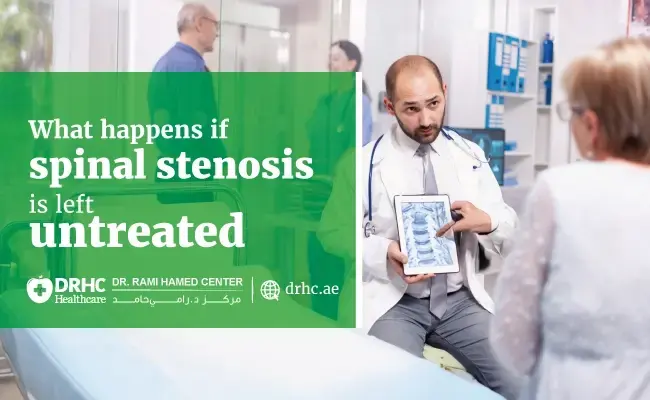
Have you ever noticed that your foot drags while walking or that you have to lift your knee higher than usual to avoid tripping? This condition—commonly referred to as foot drop—can be both alarming and frustrating. At Dr. Rami Hamed Center (DRHC) in Dubai, we often see patients experiencing foot drop due to underlying issues in the lumbar spine.
We understand how frightening it can be to suddenly lose control or strength in your leg. Fortunately, many cases can be improved or even reversed with timely and appropriate treatment. Let's explore how problems in the lower spine can lead to foot drop, and what you can do about it.
What Is Foot Drop?
Foot drop is not a disease but a symptom. It refers to difficulty lifting the front part of the foot, causing it to drag while walking. People often compensate by raising their thigh higher with each step—this is called a "steppage gait."
While foot drop can have several causes, one common origin is nerve compression in the lower back, especially in the lumbar spine region.
How the Lumbar Spine Affects the Foot
The lumbar spine contains nerves that control the muscles in your legs and feet. When one of these nerves—especially the L4, L5, or S1 nerve roots—is compressed or damaged, it can affect the ability to lift the foot.
Common lumbar spine conditions that may cause foot drop include:
- Lumbar disc herniation: A slipped or bulging disc can press on a spinal nerve.
- Spinal stenosis: Narrowing of the spinal canal can compress nerve roots.
- Spondylolisthesis: When a vertebra slips out of place, it can irritate nearby nerves.
- Nerve root injury during surgery or trauma: Rare but possible.
The L5 nerve root is most often involved in foot drop, as it controls the muscles responsible for lifting the foot and big toe.
Explore Our Related Blogs
- What causes spinal cord compression in cervical spondylosis
- How untreated spondylolisthesis leads to nerve damage
- How degenerative disc disease progresses to facet joint arthritis
- How sacroiliac joint dysfunction mimics low back pain
Frequently Asked Questions (FAQs)
Q: Is foot drop painful?
Not always. Some patients experience pain, tingling, or numbness in the leg or foot, while others simply notice weakness without pain. Pain may suggest ongoing nerve irritation or inflammation.
Q: Can foot drop go away on its own?
In some mild cases, yes—especially if the nerve irritation is temporary. However, if the underlying nerve compression continues, the weakness can become permanent. Early evaluation and treatment are key.
Q: How is it diagnosed?
A detailed neurological exam helps identify which muscles and nerves are affected. Imaging studies like MRI of the lumbar spine can reveal disc problems or spinal stenosis. Nerve conduction studies and EMG (electromyography) may also be used to assess nerve function.
Q: What are the treatment options?
Treatment depends on the cause and severity. At DRHC Dubai, we provide a range of options, including:
- Physical therapy to strengthen muscles and improve walking.
- Medications to reduce inflammation or nerve pain.
- Bracing (ankle-foot orthosis) to support the foot during walking.
- Epidural steroid injections to relieve nerve pressure.
- Surgery (e.g., lumbar decompression or discectomy) may be considered when conservative treatment fails or the nerve compression is severe.
Q: How long does recovery take?
Recovery varies widely. Some patients improve within weeks, while others may take months. In cases of prolonged or severe nerve damage, full recovery may not be possible. However, with the right combination of therapies, quality of life and mobility can significantly improve.
When to Seek Help
If you’re noticing any new weakness in your foot, trouble walking, or persistent numbness or tingling in your leg, don’t ignore it. These could be signs of nerve involvement in the lumbar spine, and early diagnosis offers the best chance for recovery.
At Dr. Rami Hamed Center (DRHC) in Dubai, our team of spine specialists and neurologists work together to accurately diagnose and treat the underlying causes of foot drop. Whether you need conservative care or a more advanced intervention, we are here to guide you every step of the way.
Conclusion: Hope Begins with the Right Diagnosis
Foot drop can be a distressing symptom, but it doesn’t have to define your future. When caused by lumbar spine conditions, timely treatment can make all the difference in restoring function and preventing further nerve damage.
If you or a loved one is experiencing signs of foot drop, we invite you to schedule a consultation at DRHC Dubai. Our multidisciplinary approach ensures that you receive compassionate, personalized care—focused on helping you walk with confidence again.
Dr. Rami Hamed
Consultant Spine & Orthopedic Surgeon
Founder, DRHC – Dubai Healthcare City
📞 +971 4 279 8800
🌐 www.drhc.ae
📍 Dubai Healthcare City, Building 52
Topic: orthopedic Spine Surgery




.jpg)




Leave a comment